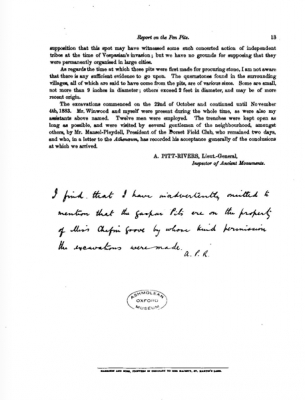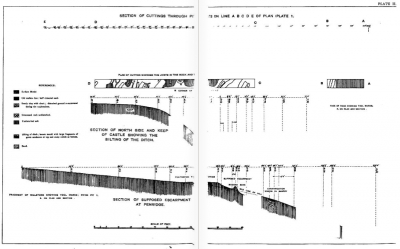To search the RPR site click here
Peter Rivière
On Thursday, 29 August 1878, as part of the 30th Annual Meetings of the Somersetshire Archaeological & Natural History Society, members made a field excursion which included a visit to Pen Pits, a prehistoric site, near the village of Penselwood, The site consisted of a very large number of pits spread over several hundred acres. The place had been the focus of antiquarian interest since the beginning of the century when Sir Richard Hoare, owner of neighbouring Stourhead, had investigated the place and reached no firm conclusions as to its nature. Nor was this the first time that members of the society had visited Pen Pits, having previously done so in 1857. The 1878 visit, however, gave rise to a more determined effort to reveal the nature of the remains and one in which Pitt-Rivers, as Inspector of Ancient Monuments, would become embroiled.
The evening before the excursion, there had been a discussion about the various places to be visited next day, including Pen Pits.[1] Thomas Kerslake, [2] who was regarded as the expert on the site, read from a pamphlet [3] in which he argues that Pen Pits were the remains of a large and populous pre-Roman city, Cair Pensauelcoit. His thesis was entirely based on a rather questionable etymological interpretation of various names that occur in early historical documents. Some of those present agreed with him whereas others claimed it had simply been a quarry. The following day the discussion continued at the site with Kerslake again reading further extracts from his pamphlet, with once again some supporting his argument and others not. Out of the discussions came the decision that a proper investigation of the site should be undertaken. A subscription would be raised and competent scientific advice obtained. Accordingly some money was raised and a Committee formed, with Mr Wilkinson, Rector of Penselwood as its Secretary. Some members of the Committee wanted to start work in the autumn of 1878, however it was decided to wait until William Boyd Dawkins [4] and the Rev H H Winwood [5] had visited the site.[6] These two together with Mr Wilkinson made a survey on 1 January 1879 and Dawkins furnished a report from which the possibility of human habitation in some of the smaller pits was not excluded but came down mainly on the site as a quarry.[7]
The Committee had several preliminary meetings during 1879 but the main investigation began on 23 September when Pitt-Rivers was present. Pitt-Rivers was a member of neither the Society, nor the Committee, nor yet was he the Inspector of Ancient Monuments, but had merely been invited to assist. His contribution consisted of a plan of the site known as Orchard Castle and a section cut through one of its so-called ramparts. The remains he found were all of mediaeval origin, with nothing earlier than Norman. Indeed the outline of the castle was a typically Norman layout with keep and bailey. During the excavation a pit was discovered beneath the rampart thus indicating the former’s greater age. The report of the Committee [8] was prepared by Winwood and it concluded that, despite the limitations on the investigation by the lack of funds, there was no evidence that the pits were ever intended as dwellings but were the remains of mines for the extraction of the local hard Greensand rock. There were three mildly dissenting voices but their main complaint was that given the extent of the excavations these could only be tentative findings and more work was required. The person totally unwilling to accept these findings was Kerslake, and in 1882 he responded with a re-assertion that Pen Pits was the site of Caer Pensauelcoit, a pre-Roman British metropolis.[9] In the same document he complained bitterly that the Somersetshire Society having persuaded him to attend the visit to Pen Pits had refused to listen to what he had to say and had seriously distorted his arguments in its report.
Pitt-Rivers took up the position of Inspector of Ancient Monuments on 1 January 1883. He must have decided early in his tenure that Pen Pits deserved official attention because the site was gradually being destroyed by levelling to bring the land under cultivation. It was, he thought, important that a conclusion be reached on the nature of the site before it disappeared in order to see whether it was of sufficient significance to deserve saving. He conducted his investigations from 22 October to 4 November 1883. These mainly consisted of excavating a section across the site in the area known as Gaspar Common. In the middle of November news of the excavation was brought to public notice by two remarkably similar short paragraphs in The Morning Post and The Athenaeum. They read almost like press releases, and clearly on behalf of Kerslake’s position. The entry in The Athenaeum reads thus:
General Pitt-Rivers, with eight or nine excavators, has lately devoted some days to explorations at Penselwood, the site of the ancient British city Caer Pensauelwitt, that was invested for seven days by Vespasian under Claudius, A.D. 47.[10]
The following month, John C. Mansel-Pleydell, the President of the Dorset Field Club who had attended the excavation for two days, wrote to The Athenaeum pointing out that this report was misleading since no evidence of habitation had been found at the site.[11] In January 1884, Kerslake responded, stating that Pitt-Rivers’ excavations only concerned a very small part of the total site. He, Kerslake, had never denied that quarrying had been carried out there, but his argument was concerned with the much larger area of which the excavated part represented only a very small proportion. He repeated his assertion that this was the location of Caer Pensauelcoit [12]
Pitt-Rivers produced the official report of his investigations for the Commissioner of Works on 10 July 1884 [13]. The investigations, conducted with Pitt-Rivers’ normal attention to detail, fully supported the conclusion that these pits were mines for the extraction of rock to be used as querns and revealed no evidence that the pits were ever constructed for or used as habitations. This, however, was not the end of the controversy. Under its ‘Anthropological Notes’, The Athenaeum summarised Pitt-Rivers’ report in its issue of 23 August [14] to which Kerslake once again replied in an identical vein to his earlier claim but now added that Pitt-Rivers’ ‘Report overflows its commission into misrepresentations of what I had set forth upon the broader and superior historical induction which I had brought to bear upon the locality’. He continues by blaming the Somersetshire Archaeological Society for its antagonism to his ideas and accuses them of seeking the support of eminent authorities. In fact he sees Pitt-Rivers’ involvement as an attempt to give official credence to the position. He ends his letter thus: ‘How long will it be before we shall get accustomed to see the Authority of the Crown itself to be appealed to as the final argument in an historical controversy?’ [15]
On 15 September 1884, The Times published an anonymous article on Pen Pits whose author, inspired by Kerslake’s ideas, parrots his arguments.[16] The surprising thing is that it contains no reference at all to Pitt-Rivers’ report published two months earlier. Ten days later (25 September), The Times published Pitt-Rivers’ response, in which he drew attention to his report and briefly reiterated the evidence for dismissing Kerslake’s theory.[17] Two days after that an anonymous writer in the Saturday Review, wrote in support of Pitt-Rivers and mocked The Times correspondent as someone ‘who had nothing better to do, and who evidently knew more about the art of writing entertaining articles in a clear style than he did about prehistoric archaeology’. [18] Kerslake, however, was determined to have the last word and wrote to The Times complaining that Pitt-Rivers has gratuitously misrepresented him. For himself he is gratified at ‘having demonstrated an unobserved incident of our earliest history’ but he is growing ‘wearisome’ at continuing to fight the members of the Somersetshire Archaeological Society whom Pitt-Rivers has recruited as his auxiliaries.[19] The Times, however, abbreviated his letter, so Kerslake set out his argument in full in a 57-page pamphlet the following year.[20] His complaint was that Pitt-Rivers in his official position as Inspector of Ancient Monuments had decreed by fiat the nature of Pen Pits, leaving no room for other scholarly interpretation. He got the last word in as no one made a rejoinder. Indeed there the matter appears to have rested since no one seems to have taken further interest in the question. Today the Victoria County History hedges its bets and merely notes that ‘The land east of Penselwood village above the Stour, called Pen Pits by 1589, was formerly claimed to have been a 'primitive metropolis' and later as whetstone quarries perhaps dating from the Roman period.[21]
Notes
[1] Proceedings of the Somersetshire Archaeological and Natural History Society [hereafter Proceedings], 24 (1878), p.54.
[2] Thomas Kerslake (1812-1891) was a bookseller based in Bristol (see ODNB). He plays a central role in this dispute.
[3] This was presumably excerpts from his A primæval British metropolis. With some notes on the ancient topography of the south-western peninsula of England. Bristol, 1877.
[4] Sir William Boyd Dawkins, FRS (1837-1929) was a geologist and palaeontologist (see ODNB).
[5] Henry Hoyte Winwood (1830-1920) was a Bath clergyman who took an active interest in geology. For a brief obituary, see Nature, 106 (6 January 1921), p. 605.
[6] Proceedings, 24 (1878), pp. 56-9.
[7] Proceedings, 24 (1878), pp. 59-61.
[8] Proceedings, 25 (1879), pp. 6-17.
[9] Kerslake, Thomas, Caer Pensauelcoit, a long lost unromanised British metropolis, a reassertion, by the author of 'A primæval British metropolis', London, 1882.
[10] ‘Fine-Art Gossip’, Athenaeum, 2925 (17 November 1883), p. 17 p.643. See also The Morning Post, 16 November 1883, p.5.
[11] Mansel-Pleydell, J C, ‘The Penselwood Pits’, Athenaeum, 2928 (8 December 1883), p.741.
[12] Kerslake, Thomas, ‘Caer Pensauelcoit’, Athenaeum, 2937 (9 February1884), p.187.
[13] Pitt-Rivers, A., Report on excavations in the Pen Pits, near Penselwood, Somerset. London: Harrison & Sons, 1884.
[14] ‘Anthropological Notes’, Athenaeum, 2965 (23 August1884), p.244.
[15] ‘Anthropological Notes’, Athenaeum, 2967 (6 September 1884), p.309.
[16] Anon., ‘The Pen Pits’, The Times, 31239, 15 September 1884, p. 3; col B.
[17] Pitt-Rivers, A., ‘The Pen Pits’, The Times, 31248, 25 September 1884, p. 4; col F.
[18] ‘The Pen Pits’, Saturday Review of Politics, Literature, Science and Art, 58:1509 (27 September1884), p.407-8.
[19] The Times, 31268, 18 October 1884, p.4; col B.
[20] Kerslake, Thomas, The liberty of independent historical research [a reply to Report on excavations in the Pen pits, near Penselwood, by A.H.L. Fox-Pitt-Rivers.]. London: Reeves & Turner, 1885.
[21] 'Penselwood', A History of the County of Somerset, Volume 7: Bruton, Horethorne and Norton Ferris Hundreds, 1999, pp. 184-192.
Note; Obviously for part of the time covered by this dispute Pitt-Rivers was actually surnamed Lane Fox, but Pitt-Rivers has been used throughout for ease of reference.
May 2012





